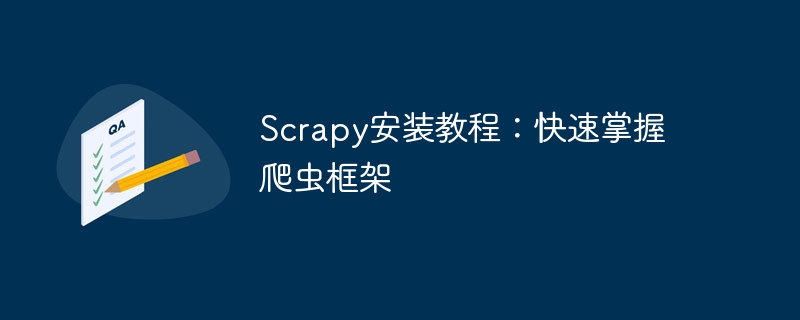Home >Backend Development >Python Tutorial >Learn to quickly deploy the Scrapy crawler framework: installation guide
Learn to quickly deploy the Scrapy crawler framework: installation guide
- 王林Original
- 2024-02-18 21:07:06993browse

Scrapy installation tutorial: Quickly master the crawler framework, specific code examples are required
Introduction:
In the Internet era, data has become one of the important resources. As a method of obtaining network data, crawler technology is increasingly favored by enterprises and individuals. As one of the most popular crawler frameworks in the Python language, Scrapy can help developers collect and process data quickly and efficiently. This article will introduce the installation process of Scrapy and help readers quickly master the use of the Scrapy framework through specific code examples.
1. Install Scrapy
- Confirm the Python environment
Before installing Scrapy, you first need to confirm that the Python interpreter has been installed and the version is 2.7 or 3.4 or above. You can confirm the Python version by enteringpython --versionon the command line. -
Installing Scrapy
Installation of Scrapy is very simple, just enter the following command on the command line:pip install scrapy
This will automatically install Scrapy from the Python Package Index (PyPI) Download and install the latest version of Scrapy. Note, before installing Scrapy, make sure you have the pip tool installed.
- Verify installation
After the installation is complete, you can use thescrapy versioncommand to verify whether Scrapy is successfully installed. If the installation is successful, Scrapy version information will be displayed.
2. Scrapy sample code analysis
In order to help readers better understand the use of Scrapy, the following will analyze the core concepts and basic usage of Scrapy through a specific sample code.
import scrapy
class MySpider(scrapy.Spider):
name = 'example'
start_urls = ['http://example.com']
def parse(self, response):
# 解析网页内容并提取数据
title = response.css('h1::text').extract_first()
content = response.css('p::text').extract()
yield {
'title': title,
'content': content
}
# 翻页操作
next_page = response.css('a.next-page-link::attr(href)').extract_first()
if next_page is not None:
yield response.follow(next_page, self.parse)
- Create Spider class
TheMySpiderclass in the above code inherits fromscrapy.Spiderand sets anameattribute and astart_urlsattribute. Thenameattribute is used to name the Spider, and thestart_urlsattribute defines the Spider's starting URL list. - Parse web pages
parseThe function is a special function in Scrapy, used to parse web page content. In the sample code, we use theresponse.cssmethod and pass in the CSS selector to extract elements. For example,response.css('h1::text')can extract the text content in the h1 tag. Use theextract_firstmethod to get the first element extracted, and theextractmethod to get all elements that meet the conditions. - Data processing and next page capture
After parsing the web page content, we use theyieldkeyword to return the extracted data in the form of a dictionary. In addition, the sample code also demonstrates how to perform page turning operations. Throughresponse.follow(next_page, self.parse), you can automatically jump to the next page in the current page and call theparsefunction to parse the new page.
3. Summary
Through the introduction and code examples of this article, I believe that readers have a certain understanding of the installation and basic usage of the Scrapy framework. Scrapy not only provides a simple and efficient crawler framework, but also provides powerful data processing and automatic jump functions. Readers can further master the advanced usage of Scrapy according to their own needs, such as setting request headers, using proxy IP, etc. In practical applications, different Spider classes can also be written for different websites to make the crawler more flexible and reliable.
I hope this article can help readers learn in depth in the field of crawlers. You are welcome to further improve your knowledge system through Scrapy official documents and other related materials. I wish everyone can complete various crawler tasks more smoothly and efficiently when using the Scrapy framework.
The above is the detailed content of Learn to quickly deploy the Scrapy crawler framework: installation guide. For more information, please follow other related articles on the PHP Chinese website!

